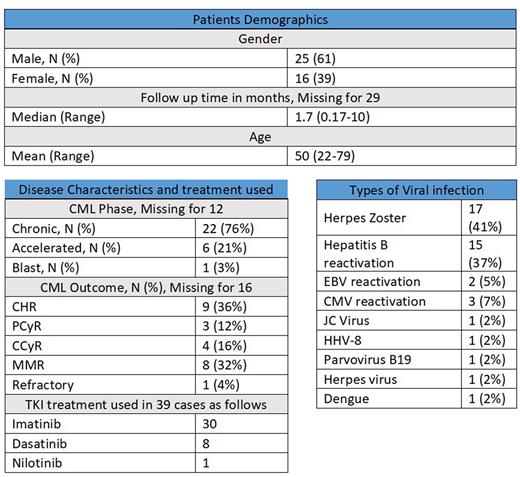Abstract
Introduction
Chronic Myeloid Leukemia (CML) is a myeloproliferative neoplasm characterized by the unregulated growth of myeloid cells, resulting in a proliferation of mature granulocytes. The reciprocal translocation, which results from the fusion of the breakpoint cluster region (BCR) gene on 22q11.2 and the Abelson murine leukemia (ABL1) gene on 9q34.1 is the hallmark of the disease and results in a BCR/ABL1 fusion product with abnormal tyrosine kinase activity, which plays a role in the unregulated cell proliferation. CML accounts for 15-20% of adults leukemias. Tyrosine kinase inhibitors (TKI) have revolutionized the treatment of CML, as it is highly successful and has transformed the prognosis of patients with CML. However, TKIs may be associated with an increased risk of infections. This review highlights the risk of viral infections in patients with CML.
Methodology
We have performed a literature search for English language articles using PubMed, Scopus, and Google Scholar, for the period 2001-2022. And population consisted of patients over 18 years old with a diagnosis of CML and no history of BMT. Articles include case reports, case series, informative reviews, and clinical trials. The keywords were " CML, Chronic Myelogenous Leukemia, Viral, Infection." Search results were initially reviewed by title and abstract, and articles were selected for more in-depth analysis if deemed relevant. Pertinent articles were examined in-depth for this report.
Results
In an analysis of 41 patients, with 25 males and 16 females, M:F ratio of 1.56:1, and the median age of 50. Age ranged from 22 to 79 years. Most patients with reported viral infections or reactivations were in the chronic phase of CML, with 22 patients (76%) in the chronic phase, 6 patients (21%) in the accelerated phase, and one patient (3%) in the blast phase. Most cases with reported outcomes responded to treatment to CML; only one had refractory disease, and 8 cases (32%) had Major molecular response. Imatinib was the most commonly used TKI in 30 patients (77%). The most commonly reported viral reactivations were Herpes zoster in 17 cases (41%), followed by Hepatitis B reactivation in 15 cases (37%).
Conclusion
Patients with a diagnosis of CML have a high risk for viral infections, mainly reactivation of latent viruses like varicella zoster and hepatitis B; this is likely because of the disease itself; adaptive immune responses are dysfunctional in CML patients at diagnosis before starting TKI treatment and before the progression to overt immune deficiency secondary to blastic transformation, as evident by the large number of patients having viral reactivation in the chronic phase; reasons included dysfunctional CD8+ cytotoxic T-cells (CTLs). On the other hand, treatment by TKI can increase this risk of viral reactivation; therapy with imatinib was associated with significant reductions in IgM memory B cells. This review shows the importance of having a hepatitis B serology checked before starting TKI therapy, close monitoring and clinical suspicions for viral infections or reactivations in patients with CML on TKIs; further clinical trials are needed to assess the need for viral prophylaxis for CML patients after starting TKIs.
Disclosures
No relevant conflicts of interest to declare.
Author notes
Asterisk with author names denotes non-ASH members.


This feature is available to Subscribers Only
Sign In or Create an Account Close Modal